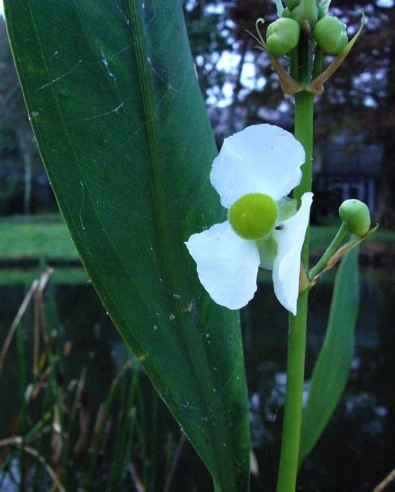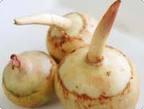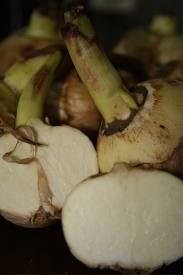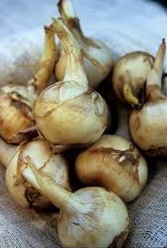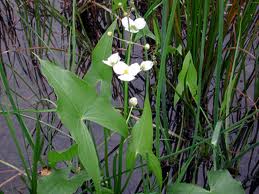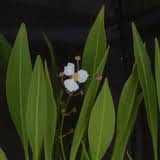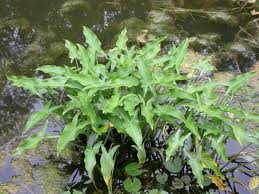Sagittaria Lancifolia: Duck Potatoes, Wapato
Artificial grass is not grass. Non-dairy creamer contains a dairy product. And ducks don’t eat duck potatoes. Humans do.
Oh, ducks may eat one by mistake from time to time, just like they might eat a piece of grass artificial. And if you’d like know, non-dairy creamer has sodium caseinate, a product made from milk. Don’t believe me? Read the label. But ducks still don’t eat duck potatoes for the most part. However, people do and have presumably done so for thousands of years
Duck potatoes are chestnut-size tubers — corms really — found around the shallow-water plant like numbers on a clock. Their family name, Sagittaria, (saj-ee-TAR-ee-uh ) means “arrow” and describes the leaves of a lot of members in this family. Look up your local version because they vary. They are found in non-desert North America.
Locally three are found: Sagittaria latifolia (lat-ih-FOH-lee-uh) — wide leaf, shaped similar to a delta; Sagitaria lancifolia (lan-sih-FOH-lee-uh) — lance leaf, think spear point, the one pictured on top; and Sagittaria graminea (gram-IN-ee-uh) — grass-shaped leaves, more along the lines of cattails. Generally the bigger the leaf in structure, usually the larger the potatoes. The S. latifolia tends to have the best “duckies.” The S. lancifolia and S. graminea really don’t have potatoes per se but the ends of the stalk are edible like lower cattail stalks and has starch. There is also a grassy one that grows underwater that we aren’t too interested in: Sagittaria kurziana.
Sagittarias are aquatic but they don’t go for deep water. They’re waders not swimmers and so are we. Shuffle around a plant with your feet to loosen the tubers which then float to the top, a technique that still works, as does a small rake. Just keep raking in the same spot because the tubers are at varying depths in the mud. Pulling the plant up usually doesn’t work. Native Americans would also raid muskrat middens where the water rat had packed them. One often reads about native raiding muskrat rents but not beaver dens. That’s because the muskrat, like the otter, builds its den in the bank and the beaver creates his own little island paradise.
Duck potatoes, also called Arrowhead, Watato or Wapati, or Katniss, can be eaten raw, should you be in a survival situation. But, they’re bitter and don’t taste good. A little cooking, like a little wine at closing time, can make all the difference in the world. Boiled or roasted for about a half hour, they become worth getting wet for again (just remember to cut off the sprout before cooking and peel after cooking.) Once cooked, they can be used like potatoes. They can also be dried and ground into powder for soups and bread.
Besides being part of the staple of Indian life, duck potatoes were also the entre and dessert for Lewis and Clark on their famous expedition. According to their diaries, Duck Potatoes and elk were their main fare while they were on the Columbia River, now in present day Oregon. Sometimes Lewis and Clark, who lived off the land, would be without food and were forced to eat their work animals. Other times they literally had to club game animals out of the way. I’ve seen that in some parts of the world with rabbits, particularly northern Scotland and railroad tracks. Incidentally, if all you had to eat were rabbits you would die from lack of saturated fats.
And by now I know you are just anxious to know why don’t ducks eat duck potatoes? They do eat the seeds but not the potatoes. Why? Size mostly. By the time the potatoes are available they are too big for most ducks to be interested in. They should have been more correctly named Swan or Goose Potatoes. Geese can swallow golf balls, but then of course, they would lay eggs with dimples…. Actually, in some places duck potatoes are known as Swan Potatoes. Incidentally Sagittaria are not environmentally totally “green.” They release methane into the atmosphere, their own little global warming contribution, another reason to reduce their population propagation by proper gastronomic preparation.
If by chance you want to try duck potatoes and you don’t want to get wet or risk misidentifying the plant you might try your nearest Asia market. They sometimes carry them in the New Year. Elsewhere internationally, Sagittaria were introduced to Australia a while ago — first noticed in 1959 — and are now considered a noxious weed. Where are the aborigine foragers when you need them? Again, if one has enough of them to make them a noxious weed then one also has enough for several banquets. Eat The Weeds.
Other edible parts of the Sagittaria include young unfurling leaves and stalk. Boil them like any green. The flower stalks before the blossom are also a tender tidbit, again, boil them. Lastly, the lateral tips of the growing rhizomes are also edible, raw or cooked. The petals of the white blossoms are edible raw. They are delicat. Light. A little minty. Sweet.
WARNING: The Sagittaria latifolia has some resemblance to the Arum, which is toxic. However, the Arum leaf is veinless nor does it blossom the same way. More so, if you bite into an unprepared Arum root you will know you have erred significantly. It burns.
Jerky and Duck Potatoes
A recipe with flavors from the past:
1 pound beef jerky or dried buffalo
1 cup hominy grits soaked overnight in a lot of water
1 large onion chopped
1 pound cooked duck potatoes
salt and pepper to taste
Break the jerky up into one-inch pieces and put in a heavy, lidded pot. Drain the hominy, add to the jerky, along with the onion. Cover with water, bring to a boil. Simmer, covered, until the hominy is tender, about 2 hours, add water if necessary. Last 20 minutes add cooked duck potatoes, adjust liquid to how you like your stew. Salt and pepper to taste.
Green Deane’s “Itemized” Plant Profile
IDENTIFICATION: Height to three feet above water, can grow to six feet under favorable conditions. Arrow or lance-shaped leaves, two to four inches wide, long separate stalk with large three petal blossom, one to two inches wide.
TIME OF YEAR: Blooms throughout the year in warm areas, sets potatoes year round, best in fall, grow like a fan out and around the base of the plant. Pulling up the plant will not looses the potatoes, work the muck to get them.
ENVIRONMENT: Shallow water of swamps, ditches, lakes and streams. Make sure the water is not polluted.
METHOD OF PREPARATION: “Potatoes” edible raw but bitter, boil or roast for 30 minutes, then eat or use like potatoes. Young leaf and stalk boiled, flower stalk boiled, rhizome tips raw or cooked. Blossom’s white petals edible raw.

